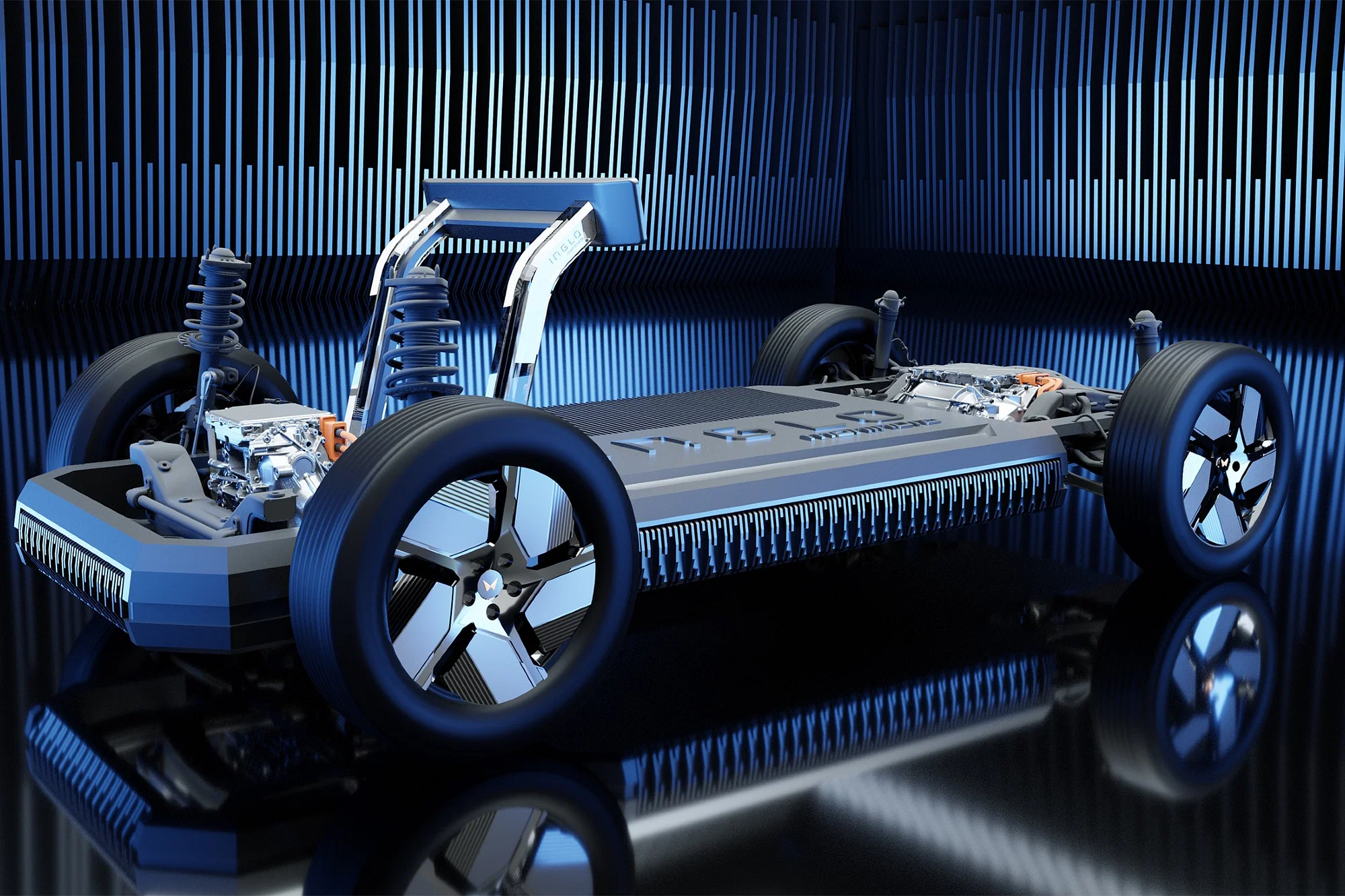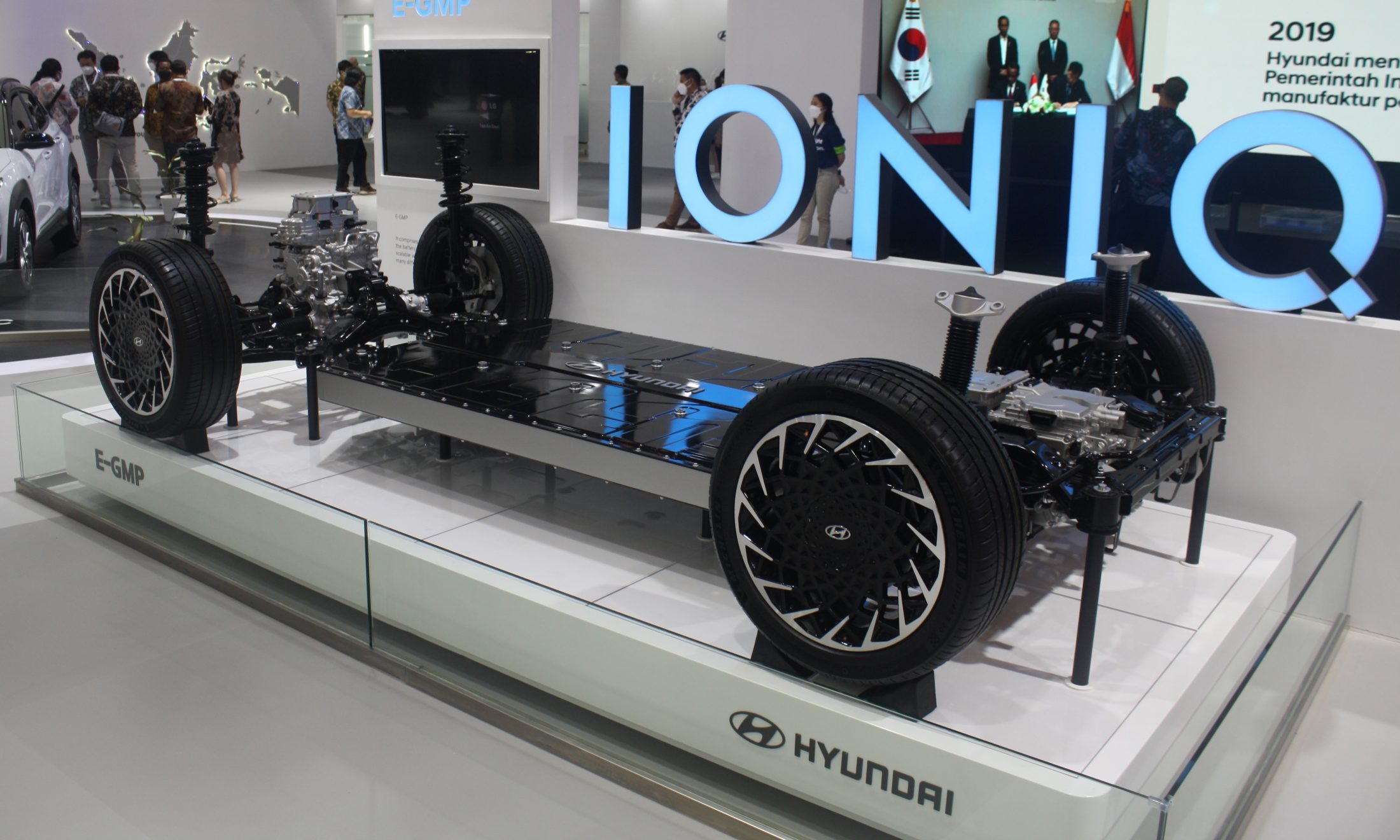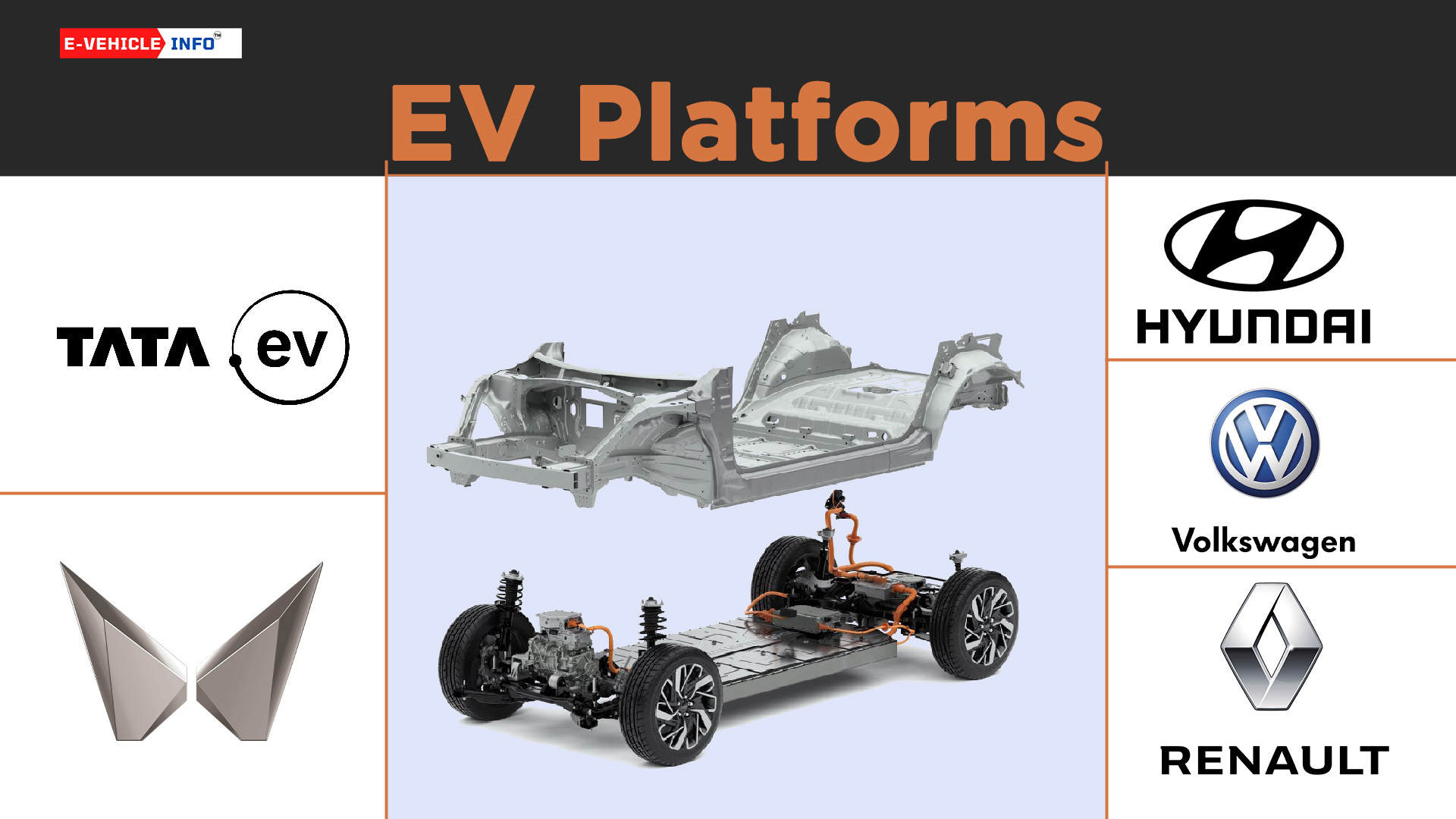Table of Contents
EV Platforms
What is an EV Platform?
A platform is a primary vehicle frame without a power unit (an engine or a motor), a chassis, or a body. The basic structure is based on the concept that this platform will act as a fully autonomous system that consists of many components of an EV, such as battery assembly, wheels, and suspension system. Adjusting the platform’s length and width and changing the number of small batteries in the assembly will be adjusted according to the manufacturer’s requirements.

In the ever-changing landscape of electric vehicles (EVs), the foundation upon which these ground-breaking automobiles stand plays a critical role in shaping the future of sustainable mobility. Enter the world of EV platforms, the unsung heroes who provide the structural integrity and adaptability needed for the next generation of electric vehicles. This article will take you on a journey to discover the remarkable innovations in EV platform technology pioneered by industry titans Tata Motors, Mahindra, Hyundai, Renault etc. These platforms serve as the canvas on which automakers paint their visions of electric mobility, promising enhanced performance, improved efficiency, and ground-breaking design. Let’s explore each platform in detail.
Tata Motor

Tata Motors is poised to significantly contribute to India’s electric vehicle market. Recognising the tremendous growth potential in this sector, Tata is determined to establish itself as a frontrunner. To achieve this goal, the company has introduced the GEN 1 platform, which has been further modified into the GEN 2 platform. These platforms are derived from the internal combustion engine (ICE) platforms, with minor adaptations to accommodate electric motors and battery packs. Vehicles such as the Tigor EV, Nexon EV, and Tiago EV are built upon Tata Motors’ Generation-1 platform. Having successfully entered the EV industry, Tata Motors is now directing its efforts towards developing the GEN 3 platform, a revolutionary architecture exclusively designed for electric vehicles. This innovative platform eliminates the need to accommodate petrol or diesel engine equipment, enabling it to fully harness the advantages inherent to electric propulsion.
The key highlights of Tata Motors’ Gen-3 EV platform
Scalable Skateboard Platform: This platform boasts a highly adaptable skateboard design compatible with various body styles, including hatchbacks, sedans, MPVs, and SUVs. This flexibility allows Tata to cater to a wide range of consumer preferences.
Variable Wheelbase: The Gen-3 platform is engineered to be easily adjustable, allowing for the extension or reduction of the wheelbase as needed. This capability enhances versatility and supports the development of vehicles with varying dimensions.
Low Centre of Gravity: Tata achieves an exceptionally low centre of gravity by positioning the battery pack in the lower portion of the platform. This design feature enhances vehicles’ sporty handling characteristics, even with an SUV body style.
Optimised Space Management: The skateboard architecture eliminates the need for a transmission tunnel, resulting in a flat floor and additional storage space in the front (known as the frunk). This efficient space utilisation enhances the overall utility of the vehicle’s interior.
The Gen 3 platform is in its initial stages of development, with an anticipated launch date set for 2026. Tata Motors has already unveiled the concept for this platform, and the Avinya is a prime example of a car model that will be based on this cutting-edge architecture. As Tata continues to innovate and invest in electric vehicle technology, it is poised to impact the rapidly evolving Indian EV market significantly.
Mahindra

Mahindra, the Indian automotive giant, presented its strategic commitment to significantly influence the EV sector at a big event in London. This significant announcement marked the debut of Mahindra’s ground-breaking electric vehicle architecture, the INGLO platform. This platform marks Mahindra’s foray into the fast-paced field of electric vehicles, with a market launch scheduled for 2024.
Mahindra and Volkswagen have formalised an agreement involving the supply of MEB electric components, furthering their outstanding collaboration. This collaboration includes Mahindra’s Born Electric SUV line as well as future joint ventures involving charging systems and cell production projects.
The Mahindra lineup of electric SUVs will include two brands: ‘XUV,’ which will feature the Twin Peak logo in a captivating Copper hue, and the all-new electric-only brand ‘BE.’ This interesting line includes models such as the XUV.e8, XUV.e9, BE.05, BE.07, and BE.09.

INGLO platform exhibits an array of compelling features
Remarkable Power: With the capability to deliver up to 250 kW of power in an All-Wheel Drive configuration, the platform facilitates rapid acceleration, propelling vehicles from 0 to 100 km/h in an astonishing 5-6 seconds.
Endless Modularity: The INGLO platform offers exceptional flexibility by accommodating variable lengths, widths, wheelbases, and overhangs. This adaptability ensures that each SUV is tailored to suit individual lifestyles and preferences.
Battery Excellence: Mahindra equips XUV.e and BE models with an 80 kWh battery pack, leveraging next-generation LFP battery chemistry. This innovation enables swift charging, with the battery reaching an 80% charge in less than 30 minutes.
Semi-Active Suspension: The platform incorporates a semi-active suspension system that mitigates shock absorber forces. This system supports the INGLO platform’s intelligent terrain mode system.
High-Performance Computing: The INGLO platform integrates three high-performance computers and embeds 5G technology, facilitating microservices and over-the-air updates. Additionally, this advanced technology paves the way for a futuristic Augmented Reality-based Head-Up Display system.
World-Class Safety: Mahindra’s unwavering commitment to safety is evident in the platform’s design, aiming for 5-Star Global NCAP ratings. The INGLO platform boasts ultra-strong protection for the passenger cabin and the battery tray.
Mahindra will enter the EV market with the INGLO platform, combining creativity, adaptability, and cutting-edge technology to deliver a varied and dynamic range of electric SUVs. Mahindra’s daring initiative shows its commitment to defining the future of mobility by providing sustainable, high-performance electric vehicles that meet consumers’ changing needs.
Hyundai

Hyundai Motor, South Korea’s automaker, is making major gains in improving its manufacturing skills. The corporation invests heavily in research and development, opening new production facilities and developing cutting-edge platforms. In addition, Hyundai is extending its electric vehicle (EV) lineup and growing production capacity, demonstrating its unshakable commitment to remaining at the forefront of the automotive industry. The development of Hyundai’s unique platform, known as E-GMP, an acronym for “Electric-Global Platform,” is a significant milestone in the company’s desire for electrification. E-GMP is Hyundai Motor’s ground-breaking initiative, the first platform solely dedicated to battery-electric cars (BEVs). This landmark marks the beginning of a new era in Hyundai’s illustrious history, serving as the foundational cornerstone for the next generation of Hyundai BEVs.
What distinguishes E-GMP is its persistent dedication to BEVs from the start. Unlike some platforms that modify current internal combustion engine layouts for electric vehicles, E-GMP is designed from the ground up for electric propulsion. With no need for petrol or diesel engines, this platform gives designers and engineers unprecedented freedom, reinventing the possibilities of electric car design. The IONIQ 5 electric SUV, the company’s first dedicated EV based on the E-GMP platform, has been a spectacular success, demonstrating Hyundai’s pioneering attitude. Its successful entry into a new premium market class has reshaped Hyundai’s position in the automotive environment. The IONIQ 5’s allure stems in large part from its revolutionary E-GMP architecture, which provides a slew of enticing benefits, including:
Architectural features
- Passive safety steel structure that disperses impact energy and dampens the effects of a collision, keeping passengers safe.
- A smaller engine compartment made possible by a more compact engine shortens the snout and front overhang, reduces the dashboard’s volume, and creates space for the trunk.
- The flat floor enables modular interior components such as highly adjustable, completely reclining seats and a moveable multipurpose centre console.
- Longer wheelbase creates new interior proportions for more legroom and freedom to move within the car.
- Integrated drive axle makes RWD and AWD possible without protruding structure throughout the car’s floor.
Convenience features
- The high-capacity battery pack provide large-range travel to drive up to 480 Km on a single charge.
- Unlike other chargers, its 800 V high-speed charging can turn off an empty battery in 18 minutes.
- Multi-charging system supports 400 V and 800 V charging without the manual component or extra adaptor.
- Two Vehicle Ports set it distinct from the competition; it can charge external battery-powered devices such as e-bikes and electric camping equipment and has a maximum power output of 3.5 kW for added convenience.
Renault & Nissan

Renault’s innovative CMF-B EV platform, which will debut with the future Renault 5, represents a significant advancement in electric vehicles. This adaptable platform is 70% identical to the CMF-B platform used in the Clio and Captur models, resulting in cost savings and streamlined manufacturing processes. One of its distinguishing features is its remarkable cost-effectiveness, with Renault claiming a 30% reduction in manufacturing costs over the electric ZOE. Aside from cost savings, the CMF-B EV platform’s flexibility enables the development of various electric vehicle models with adjustable tracks and wheelbases to accommodate various body types and styles. Furthermore, the compact electric components of the platform eliminate the need for a gearbox tunnel, resulting in a spacious interior, flat floor, and an impressive balance of comfort and performance. The design philosophy of this platform optimises vehicle capacity, providing the space of a larger sedan within the dimensions of a compact vehicle, perfectly aligning it with the evolving demands of the electric vehicle market.
Key Benefits and Features
Cost Effectiveness: The CMF-B EV platform significantly reduces manufacturing costs, making electric vehicles more affordable to a broader range of consumers.
Modular design: It allows for various vehicle configurations, accommodating different body styles and sizes while maintaining optimal battery placement for balanced weight distribution.
Compact Engine Compartment: Because the electric motor is smaller, the engine compartment is more compact, maximising interior space and eliminating the need for a gearbox tunnel.
Spacious Interior: The platform’s flat floor and lack of a gearbox tunnel provide a spacious front seating area and ample legroom in the rear, providing passenger comfort and versatility.
Performance and Versatility: The platform’s adaptable tracks and wheelbase allow for the development of electric vehicles with a wide range of capacities and body types, ensuring the platform’s competitiveness and meeting the diverse needs of consumers in the B-segment electric vehicle market.
Volkswagen

The Volkswagen Group’s commitment to electrification has resulted in the development of their modular e-chassis. This MEB platform has been used in the production of a variety of electric vehicles since 2019. One of the platform’s key advantages is its adaptability, as it serves as the foundation for a wide range of vehicle types, from compact city cars to spacious SUVs and vans. Volkswagen Group is taking a new approach under new leadership by introducing the MEB+ platform, a revised and improved version of the MEB aimed at further enhancing the electric vehicle experience. The MEB+ platform’s impressive range is one of its standout features, offering up to 700 kilometres (435 miles) according to WLTP standards. Furthermore, it promises faster charging speeds ranging from 175 to 200 kW, ensuring convenience and significantly reducing charging times.
MEB+ Platform Highlights and Features:
Enhanced Range: The MEB+ platform’s extended range of up to 700 kilometres alleviates range anxiety and makes electric vehicles more practical for long-distance travel.
Faster Charging: With charging speeds ranging from 175 to 200 kW, the MEB+ platform enables faster and more convenient recharging, improving electric vehicle usability overall.
Modular Battery Concept: The platform enables optimal adaptation of battery capacity by providing options for different battery sizes to meet varying driving needs, thereby optimising cost-efficiency.
Interior Space: Despite having external dimensions similar to combustion vehicles, vehicles based on the MEB platform have a remarkably spacious interior, improving passenger comfort and usability.
Future-Proof: The MEB+ platform lays the groundwork for future advancements in automated driving functions. It uses Volkswagen’s next-generation battery unit cells to support advanced features and longer ranges. It also promises expanded model offerings, including an entry-level option at an affordable price, ensuring a wide range of options and customer satisfaction.
Concluding Statement: In conclusion, the ingenuity of state-of-the-art EV platforms is at the heart of the major change in electric vehicles. Tata Motors, Mahindra, Hyundai, and Renault are all pioneering new ground by reimagining electric mobility on flexible, efficient, and environmentally friendly platforms. Cleaner, greener, and more widely available transportation is only a matter of time as these platforms develop and mature. These platforms are more than works of engineering thanks to their scalable designs, cutting-edge battery technologies, and flexible architectures. Consumers can expect more electric vehicle options that meet various needs and preferences as the auto industry adopts these developments. The road to a pollution-free future has begun, and platforms like these are driving us into a new, exciting, and promising era of electric mobility.
Author’s Note
All information presented here is in the public domain. Before utilising any information, please verify it on your end. The author shall not be held responsible for any.
Read More:- EV Platform: What Exactly is the Concept Behind the EV Platform?







